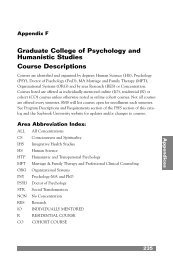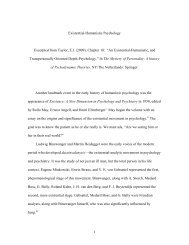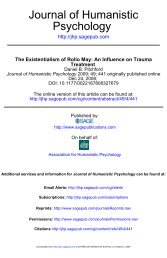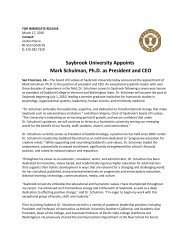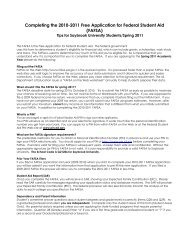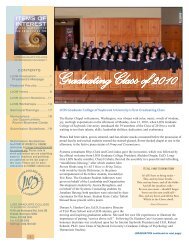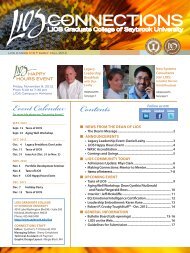Financial Resources Guide - Saybrook University
Financial Resources Guide - Saybrook University
Financial Resources Guide - Saybrook University
Create successful ePaper yourself
Turn your PDF publications into a flip-book with our unique Google optimized e-Paper software.
Section XII:<br />
Glossary Of Terms<br />
AWARD LETTER<br />
Your award letter identifies the type and amount of financial<br />
aid for which you are eligible.<br />
COA – COST OF ATTENDANCE<br />
The total amount it will cost you to go to school—usually<br />
expressed as a yearly figure. It’s determined using rules<br />
established by law. The COA includes tuition and fees;<br />
on-campus room and board (or a housing and food<br />
allowance for off-campus students); and allowances for<br />
books, supplies, and transportation. Any federal student aid<br />
you receive will help pay for your COA.<br />
DIRECT LOAN<br />
WILLIAM D. FORD FEDERAL DIRECT LOAN<br />
(DIRECT LOAN) PROGRAM<br />
Loans made through this program are referred to as Direct<br />
Loans. Eligible students and parents borrow directly from<br />
the US Department of Education at participating schools.<br />
Direct Loans include unsubsidized Direct Stafford Loans<br />
(also known as Direct Unsubsidized Loans), Direct PLUS<br />
Loans, and Direct Consolidation Loans. You repay these<br />
loans directly to the US Department of Education.<br />
DOE - DEPARTMENT OF EDUCATION:<br />
www.ed.gov.<br />
EFC – EXPECTED FAMILY CONTRIBUTION<br />
Your Expected Family Contribution (EFC) is the number<br />
that’s used to determine your eligibility for federal student<br />
financial aid. This number results from the financial<br />
information you provided in your FAFSA application. Your<br />
EFC is reported to you on your Student Aid Report (SAR).<br />
FAFSA – FREE APPLICATION FOR FEDERAL<br />
STUDENT AID:<br />
www.fafsa.ed.gov.<br />
FINANCIAL AID PACKAGE<br />
The total amount of financial aid (federal and nonfederal) a<br />
student is offered by the school. The financial aid<br />
administrator at a postsecondary institution combines<br />
various forms of aid into a “package” to help meet a student’s<br />
SECTION XII<br />
education costs. Using available resources to give each<br />
student the best possible package of aid is one of the aid<br />
administrator’s major responsibilities. Because funds are<br />
often limited, an aid package might fall short of the amount<br />
a student needs to cover the full cost of attendance. Also, the<br />
amount of federal student aid in a package is affected by<br />
other sources of aid received (scholarships, state aid, etc.).<br />
NEED ANALYSIS<br />
The process of analyzing a student´s financial need, known<br />
as need analysis, focuses on determining how much the<br />
family reasonably can be expected to contribute towards the<br />
student´s education. Traditionally, determination of an<br />
applicant´s need is achieved by collecting information about<br />
the family´s income, assets, and living expenses. For the<br />
federal student aid programs, the law specifies a need<br />
analysis formula that produces the Expected Family<br />
Contribution (EFC). The EFC and the college´s cost of<br />
attendance are used by the postsecondary school to establish<br />
the student´s need as well as to award grants, campus-based<br />
aid, and subsidized loans.<br />
PIN – WWW.PIN.ED.GOV.<br />
Your PIN can be used each year to electronically apply for<br />
federal student aid and to access your Federal Student Aid<br />
records online. If you receive a PIN, you agree not to share it<br />
with anyone. Your PIN serves as your electronic signature<br />
and provides access to your personal records, so you should<br />
never give your PIN to anyone, including commercial<br />
services that offer to help you complete your FAFSA. Be sure<br />
to keep your PIN in a safe place.<br />
PRINCIPAL<br />
The amount of money borrowed by the student. Interest is<br />
charged on this amount.<br />
PROMISSORY NOTE<br />
A promissory note is a binding legal document you sign<br />
when you get a student loan. It lists the conditions under<br />
which you’re borrowing and the terms under which you<br />
agree to pay back the loan. It will include information on<br />
how interest is calculated and what deferment and<br />
cancellation provisions are available to the borrower. It’s very<br />
25



